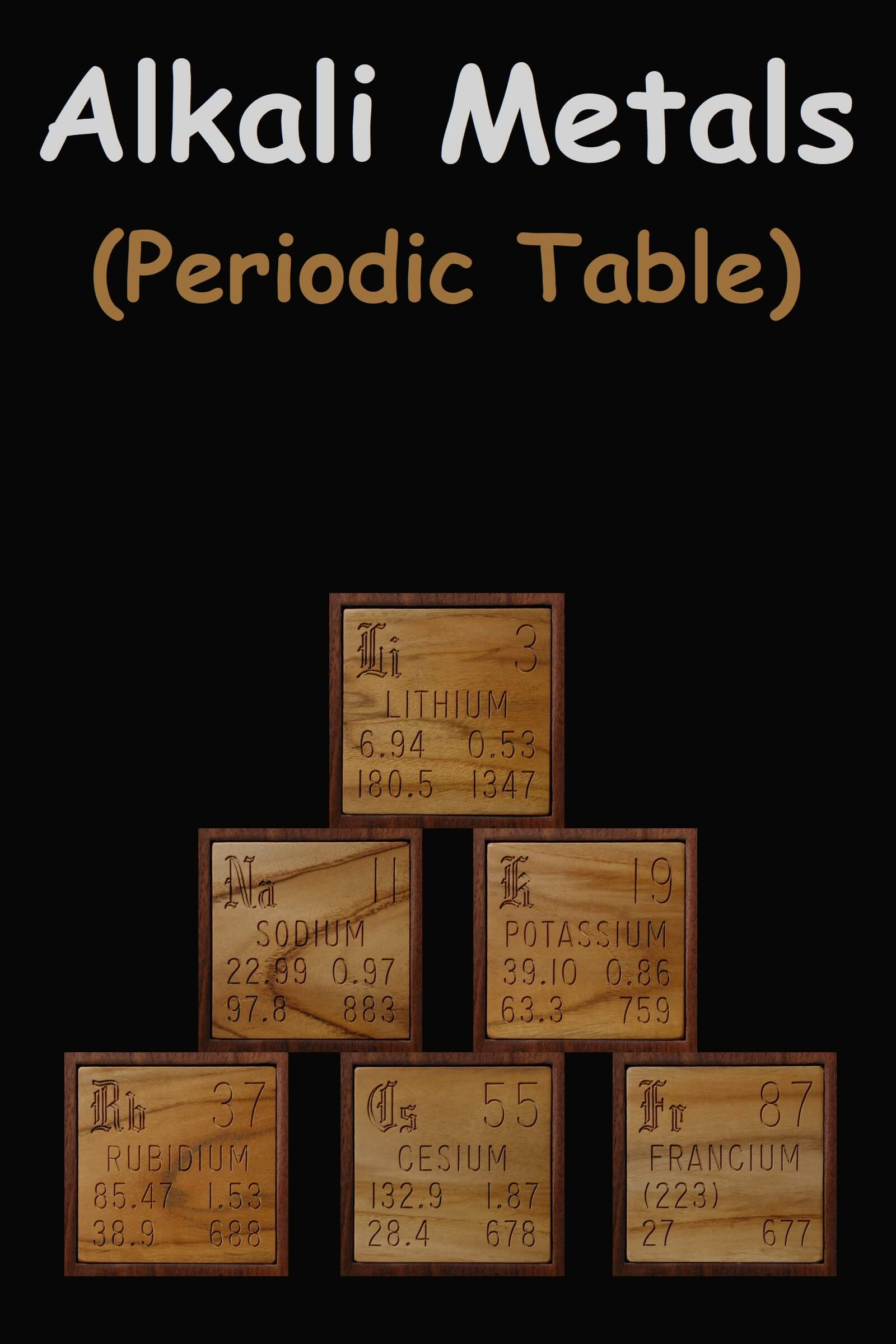Alkali Metals on The Periodic Table
What are alkali metal? What are their properties? These questions must be arising in your mind. So, to know about their properties and reactions, firstly we should know that what are alkali metals or where they found in nature.
CONTENT INDEX
About AM
Except hydrogen, all elements in the 1st group are alkali metals.
- Alkali metals are highly reactive chemical species that easily lose a single electron and form ionic compounds with non-metals.
- Group 1st elements consist of Lithium (Li), Sodium (Na), Potassium (K), Rubidium (Rb), Caesium (Cs), Francium (fr).
- They are shiny, softly, silvery metals.
- They are very reactive and electropositive.
- Electronic Configuration of alkali metals is ns1, here n = 2 to 7.
Occurrence
- The alkali metals, due to their high reactivity, they do not occur naturally in pure form in nature.
- Sodium and potassium are very abundant in nature, both are among the ten most abundant elements in the earth’s crust.
We have discussed above about their occurrence but do you know that what are their physical and chemical properties. Firstly, we will discuss about their physical properties further we will discuss about their chemical properties. So, physical properties of alkali metals are following:
Physical Properties of Alkali Metals
- Atomic radii increase as we move down to group.
- Ionic radii increase up to down.
- Ionization energy (enthalpy) is decrease as we move down to group.
- Hydration enthalpy decrease with increase ionic radii.
- Oxidation state of alkali metal is +1. It is unipositive ion, positive charge of these elements increases down to group.
- This group elements are typical metal and soft. So, we can easily cut them through a knife.
- Their melting and boiling points are low as we go down to group.
- Alkali metals form ionic compound.
- Density of alkali metals increase as we move down to group.
- When we heat alkali metals, they produce color.
Flame Coloration: Li-crimson, Na- yellow, K- pale violet, Rb- red violet, Cs-blue.
- All metals produce photoelectric effect except Li.
Chemical Properties of Alkali Metals
1) Reactivity and electrode potential – Alkali metals strong tendency to lose electrons. It acts as strong reducing agent.
2) Reducing characteristics – ionization enthalpy represent the tendency of atom lose electron in gaseous state.
Reducing capacity of alkali metals increases moving down to group. But here the question is arising;
- What is reducing agent?
Tendency of losing an electron to another element is known as reducing capacity and that element is called as reducing agent.
- In aqueous solution, reducing characteristics order will be
Na < K < Rb < Cs < Li
- Electrode potential measure tendency of element to lose electron.
Li E° = -3.04V
3) Reactivity towards water – This reaction violent as we move down to group.
2Li + 2H2O = 2LiOH + H2
4) Reactivity towards oxygen – This reaction violent as we move down to group.
- Li+ strong positive field so, it doesn’t permit oxide anion O22-.
5) Reactivity towards air – It form oxide and hydroxide.
6) Reactivity towards hydrogen – it forms ionic hydrides.
- All hydrides are proton donor.
7) Reactivity towards halogen – Alkali metals react with halogens to form metal hydrides. So, reactivity with halogen increases.
General characteristics of alkali metals
Generally, all compounds of alkali metals are ionic in nature.
1) Oxides and hydroxides: on combustion in excess air
- Li-LiO2 (some peroxide Li2O2), Na-Na2O2 (peroxide, some superoxide NaO2), K, Rb- super oxides.
- Stability of peroxides or superoxide is directly proportional to the size of metal ion. It means that if size will be increases, then metal will be more stable. Due to stabilization of large anion by large cation there one effect is produced which is known as lattice energy effect.
- Oxide and peroxides give hydroxides on hydrolysis.
- Alkali hydroxides are strongest base.
2) Halides: Alkali metal halides have very high melting point. And they are colorless crystalline solids.
Preparation– Alkali metal halide is formed by the reaction of oxides, hydroxides or carbonate with aqueous hydrohalic acid.
For example;
Na2O + 2HCl —> 2NaCl + H2O
Order of melting and boiling point – F>Cl>Br>I.
Water solubility– All hydrides are soluble in water.
LiF [low solubility in water] – it has high lattice energy
CsCl [low solubility in water] – low hydration enthalpy of its two ions.
3) Salts of oxo acids: Salt are formed by the reaction of alkali metals with oxo acids. Alkali metal are high electropositive and hydroxide are strong base.
- They are soluble in water and thermally stable.
- Carbonates and hydrogen carbonates are highly stable to heat.
- Stability of carbonate and hydrogen carbonate increases down the group.
Uses of Alkali Metals
Now we will discuss about the uses of alkali metals, where we can use these metals in daily life.
Uses of Lithium
- Lithium Lead (Li-Pb) alloy is used in toughened bearings while Li alloy is used in aircrafts.
- Lithium hydroxide (LiOH) is used in removing CO2 during exhaling in submarines.
- Lithium Bromide (LiBr) is used in medicine sedative.
- Li is used in primary cell as well as secondary cell.
- In form of Lithium Carbonate (Li2CO3), used for treat psychological illness.
Uses of Sodium
- Sodium is used as salt when it combines with chlorine.
- Sodium nitrate (NaNO3) is used in gun powder.
- Sodium acts as an essential mineral in all living organisms.
Uses of Potassium
- It reacts vigorously with water.
- It has less dense and floats in oil.
- Potassium hydroxide (KOH) is used in detergents.
- Potassium bromide (KBr) is used in Photographics.
- Potassium superoxide (KO2) is used in submarines.
Uses of Rubidium
- It is used in the drug which is used to treat depression.
- Rubidium nitrate (RbNO3) is sometimes used in fireworks.
Uses of Cesium
- It is used in glass.
- It is used in IR lamps, photoelectric cell and vacuum tubes.
Uses of Francium
- It is used in research. Since it is extremely radioactive and rarest element, it does not have any uses outside research.
We have discussed above about alkali metals, and their occurrence, physical and chemical properties or uses. Now I hope you get all the information about alkali metals.




